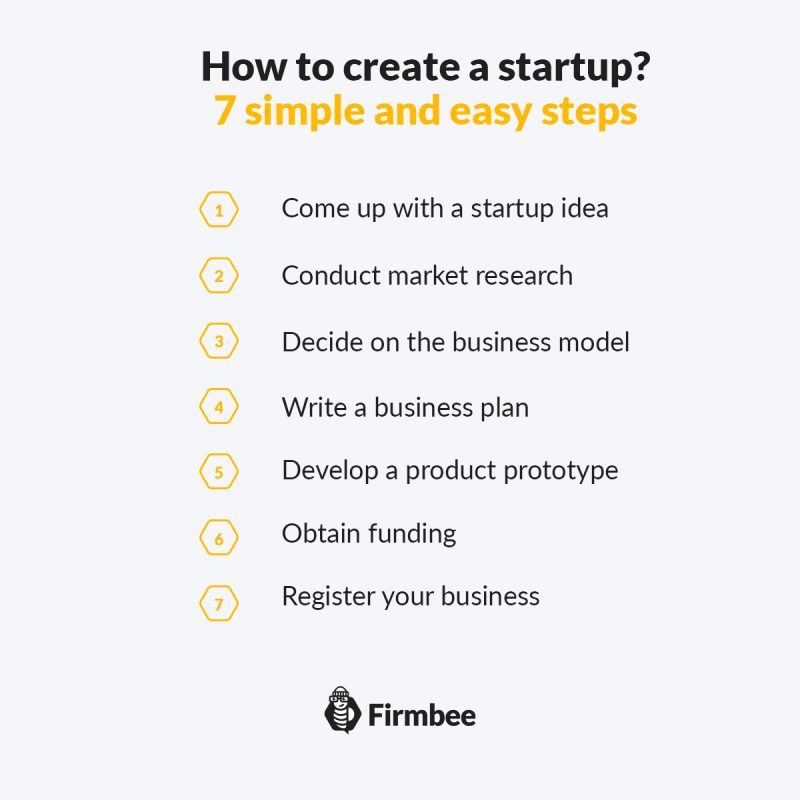How to create a startup? It takes a lot of time and effort to launch a company and get your business idea off the ground. Here’s how you can go about implementing it in 7 simple and easy steps. Read on.
How to create a startup? 7 simple and easy steps – table of contents:
- Come up with a startup idea
- Conduct market research
- Decide on the business model
- Write a business plan
- Develop a product prototype
- Obtain funding
- Register your business
- How to create a startup – summary
Come up with a startup idea
How to create a startup? Obviously, it all starts with a business idea. This is the principle of every startup. It can be found anywhere, and anything can be your inspiration. When searching for a perfect startup idea, it’s best to analyze people’s problems and think about how you can solve them. You don’t have to come up with a completely unique concept, but, for example, introduce a new application for an existing product and offer some product improvements.
Conduct market research
The next step in the process is market analysis. Estimate the market value and identify your potential competition. You should check if other companies already offer a similar product and how it differs from yours. It is necessary to determine what is its unique value, and what makes it stand out from the crowd.
It is worth analyzing both close and distant competitors. After identifying those organizations, you can look for key financial information on them. It will be the easiest in the case of listed companies. Don’t forget about examining the prices of competing products.

Decide on the business model
Now you need to determine your USP (Unique Selling Proposition), which explains why a customer should do business with you instead of one of your competitors. This requires preparing a business model. It is best to use a ready-made template, and the most popular one is the Business Model Canvas (BMC). It should include the following information:
- Key partnerships. Who are the key partners of you startup? What services are essential to the operation of your startup? What key resources do your partners own?
- Customer segments. Who are you preparing the product for? Who are your core customers?
- Key activities. What key actions need to be taken to deliver the required value? What will be the distribution channels and sources of revenue? How to establish customer relationships?
- Key resources. What key resources are necessary to offer your value proposition? What resources are required for distribution channels and planned revenue sources?
- Value proposition. What value will you deliver to the customer? What problems will be solved? What package of products and services will you offer to each customer segment?
- Customer relationships. What relationships do customers expect? How does establishing customer relationships relate to the rest of the business model?
- Channels. What channels will be used to establish relationships with customers? How will these channels be integrated? Which channel is best?
- Cost structure. What costs are generated by the adopted business model? What costs are generated by key resources, partners and activities?
- Revenue streams. What will customers pay for? How much will they pay? Will some elements of the product or service be free? What are those elements?
Write a business plan
On the basis of the accepted model, you need to write a business plan that should clarify all the previously accepted assumptions of the business model. Also, it’s time to assess the profitability of the venture. This will help you get to know your financial needs and deliver fast ROI.
Develop a product prototype
Once you have a hypothesis about your future product, concentrate on validating it. Prepare a Minimum Viable Product (MVP) that will let you test the new concept with your target audience without any special technology. With MVP, you will be able to get feedback from your customers and define a new direction for the product development.

Obtain funding
This is a good stage to look for external funding for your startup. You can get capital from various sources. For starters, it is worth turning to family and friends. Funds can be also obtained from individual investors, business angels and banks. It is a good idea to attend various startup and technology events, visit technical universities, and even use social media to seek funding.
Register your business
Registering your business is the final stage of creating a startup. Now, one of the things you have to think of is its legal business structure.Startups frequently take the shape of a corporation whose ownership is subdivided among its stakeholders in the form of shares and stocks.
How to create a startup – summary
Creating a startup is a complex process. Therefore, it is worth dividing it into several stages. Your business starts with an idea, which turns into a name and eventually becomes a reality. Startups developed according to a well-crafted action plan with a visionary strategy in mind have a greater chance of survival.
You’ve just learned how to create a startup. Do you have what it takes to launch it? Check out our project management software for developers.
If you like our content, join our busy bees community on Facebook, Twitter, LinkedIn, Instagram, YouTube, Pinterest.
Author: Andy Nichols
A problem solver with 5 different degrees and endless reserves of motivation. This makes him a perfect Business Owner & Manager. When searching for employees and partners, openness and curiosity of the world are qualities he values the most.
Launch your startup:
- What is a startup?
- Pros and cons of creating a startup
- 8 best industries for startups
- Top 5 skills every highly successful startup founder needs
- How to create a startup? 7 simple and easy steps
- 6 essential startup development stages
- How to create a startup growth strategy?
- General startup statistics you need to know
- Startup vs. corporate job. Which is right for you?
- 5 incredible companies that started in a garage
- How to find a business idea?
- How to check if your startup idea already exists?
- How to name a startup? Useful tips and strategies
- How to gain business knowledge quickly? 5 best practices
- Why do startups fail? 6 startup ideas you should avoid
- 5 weird business ideas that made millions
- Top 6 most profitable small businesses
- 7 questions to determine if your business idea is worth pursuing
- What is a buyer persona? 5 benefits of creating a buyer persona
- How to validate your business idea? 3 easy steps
- Should you follow your passion? The importance of passion in business
- What is market reseach and why is it important?
- Using social media in business
- What to do when you have too many business ideas?
- How to write a good problem statement for your startup?
- How to test your business idea for real?
- How to create a prototype for a product?
- How to build an MVP?
- How to use surveys for testing your business idea?
- 10 useful tools to validate your business idea
- What is a business plan? 4 types of business plans
- What should be included in a business plan?
- What should a product description include?
- Competitor analysis
- Marketing strategy
- Traditional business plan vs. lean startup plan
- Implementation plan. What is it and how to create it?
- Everything you need to know about patents
- Financial management for startups
- What permits and licenses does my startup need?
- What is the average startup founder salary?
- 4 startup taxes you need to pay
- Which legal structure is best for your business?
- Startup costs. How much money will you need?
- Protection of intellectual property in a startup
- Family funding vs. self-funding
- What is a shareholders’ agreement?
- What should a financial section of a business plan include?


















